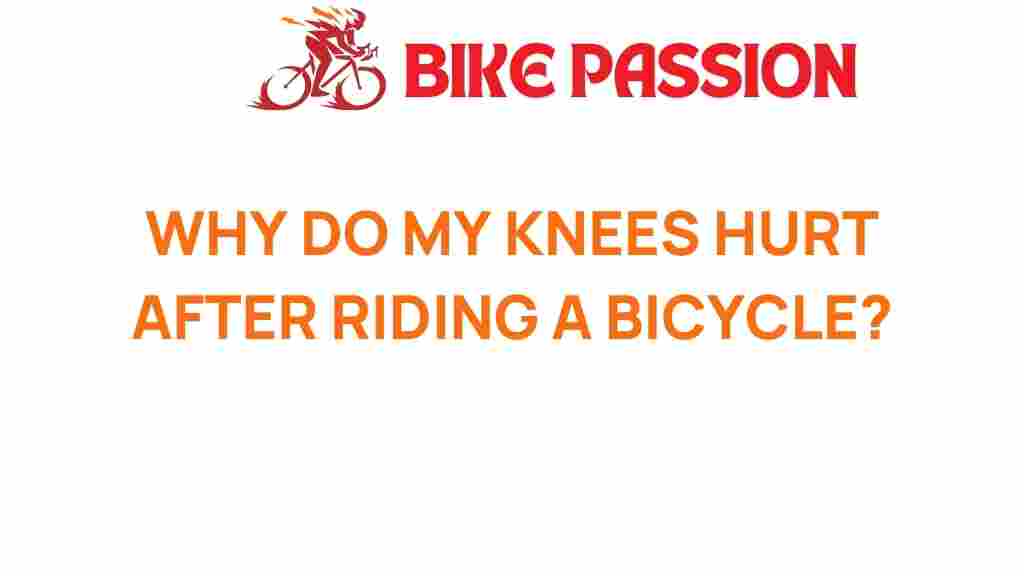Unraveling the Mystery: Why Do My Knees Hurt After Riding? – Understanding Knee Pain
Cycling is a beloved activity for many, serving as both a mode of transportation and a form of exercise. However, one common complaint among cyclists is knee pain. If you’ve ever wondered, “Why do my knees hurt after riding?” you’re not alone. This article will delve into the causes of knee pain related to cycling, discuss cycling injuries, and offer tips for recovery and prevention, ultimately enhancing your joint health and cycling experience.
The Anatomy of Knee Pain in Cyclists
To understand why your knees might hurt after riding, it’s essential to know a bit about the anatomy of the knee. The knee joint consists of bones, cartilage, ligaments, and tendons that work together to allow movement. When cycling, several factors can contribute to knee pain, including:
- Improper bike fit: A bike that isn’t adjusted correctly can lead to stress on the knees.
- Incorrect riding technique: Poor pedaling form can exacerbate knee strain.
- Overuse injuries: Repeated stress from long rides can lead to inflammation and pain.
- Weak or imbalanced muscles: Weakness in the quadriceps, hamstrings, or hip muscles can affect knee stability.
Common Cycling Injuries Leading to Knee Pain
Cycling injuries related to knee pain can include:
- Patellar Tendonitis: Inflammation of the tendon connecting the kneecap to the shinbone.
- Iliotibial Band Syndrome (ITBS): Friction of the IT band over the knee can cause pain.
- Patellofemoral Pain Syndrome: Pain resulting from improper tracking of the kneecap.
- Meniscus Tears: Injury to the cartilage that cushions the knee joint.
Step-by-Step Process to Identify the Cause of Knee Pain
If you’re experiencing knee pain after cycling, follow this step-by-step process to identify the potential causes:
Step 1: Assess Your Bike Fit
A proper bike fit is crucial for preventing knee pain. Here’s what to check:
- Seat Height: Your leg should have a slight bend at the knee when the pedal is at its lowest point. If your seat is too high or too low, it can lead to discomfort.
- Seat Position: The saddle should be positioned so that your knee is directly above the pedal axle when the pedals are parallel to the ground.
- Handlebar Height: Ensure your handlebars are at a comfortable height to prevent strain on your back and knees.
Step 2: Evaluate Your Riding Technique
Improper riding technique can contribute to knee pain. Pay attention to the following:
- Pedaling Technique: Use a smooth, circular motion rather than pushing down hard on the pedals.
- Cadence: Aim for a cadence of 70-90 revolutions per minute (RPM) to avoid excessive strain.
Step 3: Monitor Your Training Volume
Overuse injuries are common among cyclists. To prevent knee pain, consider the following:
- Gradual Increases: Increase your mileage and intensity gradually, no more than 10% per week.
- Rest Days: Incorporate rest days into your training schedule to allow for recovery.
Step 4: Strengthen Supporting Muscles
Strengthening the muscles around your knees can improve joint health. Focus on:
- Quadriceps: Exercises like squats and leg presses.
- Hamstrings: Include deadlifts and leg curls.
- Hip Muscles: Incorporate lateral leg raises and hip bridges.
Troubleshooting Knee Pain: When to Seek Help
If you’ve made adjustments and still experience knee pain, it may be time to consult a professional. Consider the following:
- Physical Therapist: They can assess your technique and provide personalized exercises.
- Bicycle Fitter: A professional bike fitting can ensure your equipment is optimized for your body.
- Doctor: If pain persists or worsens, seek medical advice to rule out serious injuries.
Recovery Tips for Knee Pain
Recovery is essential for maintaining joint health and preventing cycling injuries. Here are some effective recovery tips:
- Rest: Allow your knees to recover by taking breaks from cycling.
- Ice: Apply ice to reduce inflammation after rides.
- Compression: Use compression sleeves to support your knees during recovery.
- Elevation: Elevate your legs to reduce swelling.
Injury Prevention Strategies for Cyclists
Preventing knee pain is preferable to treating it. Here are some key injury prevention strategies:
- Regular Stretching: Incorporate stretching into your routine to maintain flexibility.
- Cross-Training: Engage in other forms of exercise to balance muscle development.
- Proper Nutrition: Maintain a diet rich in anti-inflammatory foods to support joint health.
Final Thoughts
Experiencing knee pain after riding can be frustrating, but understanding its causes is the first step towards alleviating it. By focusing on proper bike fit, riding technique, and muscle strength, you can significantly reduce your risk of cycling injuries. Remember to listen to your body and take the necessary steps for recovery and injury prevention.
For more cycling tips and resources, check out this guide on cycling techniques. And if you’re looking for professional help, consider visiting a local bike shop for a bike fit or a physical therapist for personalized rehabilitation exercises.
With the right approach, you can continue to enjoy cycling without the burden of knee pain. Happy riding!
This article is in the category Maintenance and created by BikePassion Team
